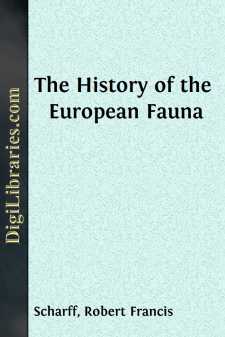Categories
- Antiques & Collectibles 13
- Architecture 36
- Art 48
- Bibles 22
- Biography & Autobiography 813
- Body, Mind & Spirit 142
- Business & Economics 28
- Children's Books 17
- Children's Fiction 14
- Computers 4
- Cooking 94
- Crafts & Hobbies 4
- Drama 346
- Education 46
- Family & Relationships 57
- Fiction 11829
- Games 19
- Gardening 17
- Health & Fitness 34
- History 1377
- House & Home 1
- Humor 147
- Juvenile Fiction 1873
- Juvenile Nonfiction 202
- Language Arts & Disciplines 88
- Law 16
- Literary Collections 686
- Literary Criticism 179
- Mathematics 13
- Medical 41
- Music 40
- Nature 179
- Non-Classifiable 1768
- Performing Arts 7
- Periodicals 1453
- Philosophy 64
- Photography 2
- Poetry 896
- Political Science 203
- Psychology 42
- Reference 154
- Religion 513
- Science 126
- Self-Help 84
- Social Science 81
- Sports & Recreation 34
- Study Aids 3
- Technology & Engineering 59
- Transportation 23
- Travel 463
- True Crime 29
The History of the European Fauna
Description:
Excerpt
PREFACE.
Our knowledge of the present and past fauna of Europe is as yet insufficient to indicate with precision the original homes of its component elements, but I hope that the lines of research laid down here, and the method of treatment adopted, will aid zoologists and geologists in collecting materials for a more comprehensive study of the history of our animals. I trust also that a fresh impulse will be given by the publication of this book to the study of the Geographical Distribution of Species. Collectors of Beetles, Butterflies, Shells, and Fossils may derive some useful hints by its perusal and thus direct their studies, so as to add, by accuracy in observation, to our knowledge of the former geographical revolutions which have moulded our islands and continents. To geographers, a survey of some of the more important changes in the distribution of land and water in past times—based upon the composition of our fauna—will be interesting. The subject, however, is a complex one. I have ventured to indicate a suitable method of treatment, and as such this attempt to elucidate the history of the European fauna should be received.
This work was written as the outcome of a paper published in the Proceedings of the Royal Irish Academy (3rd series, vol. iv., 1897), "On the Origin of the European Fauna." A summary of that paper appeared in Nature (vol. lvi., 1897), and fuller extracts of more important parts, with some criticisms, in the Geological Magazine (N.S., sec. iv., vol. iv., 1897). I freely acknowledge the value of these criticisms, which have largely assisted me to amplify and to improve upon the ideas laid down in the paper.
I have found that it greatly facilitates comprehension of the arguments used, to give a few maps indicating in a general way the extent of former seas and continents. I may in this way, as Mr. Kendall has pointed out, have submerged many square miles of land which had never been covered by the sea,—at least not within recent geological times,—but the maps were intended as illustrations of my views in a broad spirit only.
Some zoologists may be surprised that, in some cases, I have not followed the latest views in revised nomenclature. I felt that in a work of this kind it was of supreme importance to employ names still current in our leading text-books, such as Lepus variabilis for the Mountain Hare, instead of Lepus timidus. After each chapter I have endeavoured to give a short summary of contents, while a bibliography of the principal works and papers consulted will be found at the end. I should also acknowledge the aid which I have received from such excellent works of reference as the British Museum Catalogues of Birds, by Dr. Bowdler Sharpe, and those of Reptiles, Amphibia, and Fishes, by Dr. Günther and Dr. Boulenger. The valuable works on Mammalia by Sir W. Flower, Mr. Lydekker, Mr. Grevé, and Dr. Trouessart, were indispensable to me.
To Sir William Flower, Mr. Lydekker, Professor Sars, and Professor Smitt, I am especially indebted for allowing me to reproduce drawings from their works, and to my friend Mr....


